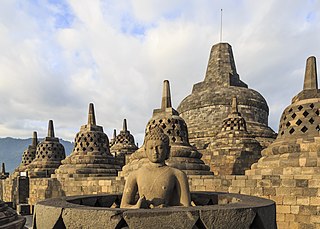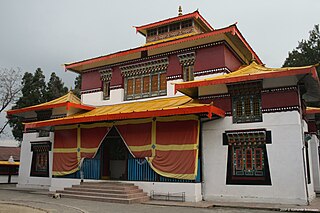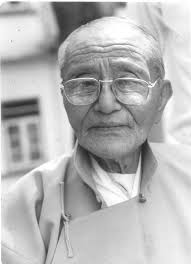Buddhism, which originated in India, gradually dwindled and was replaced by approximately the 12th century. According to Lars Fogelin, this was "not a singular event, with a singular cause; it was a centuries-long process."

Gangtok is a city, municipality, the capital and the largest town of the Indian state of Sikkim. It is also the headquarters of the East Sikkim district. Gangtok is in the eastern Himalayan range, at an elevation of 1,650 m (5,410 ft). The town's population of 100,000 are from different ethnicities such as Bhutia, Lepchas and Indian Gorkhas. Within the higher peaks of the Himalaya and with a year-round mild temperate climate, Gangtok is at the centre of Sikkim's tourism industry.

Buddhist religious architecture developed in the Indian subcontinent. Three types of structures are associated with the religious architecture of early Buddhism: monasteries (viharas), places to venerate relics (stupas), and shrines or prayer halls, which later came to be called temples in some places.

The Enchey Monastery was established in 1909 above Gangtok, the capital city of Sikkim in the Northeastern Indian state. It belongs to the Nyingma order of Vajrayana Buddhism. The monastery built around the then small hamlet of Gangtok became a religious centre. The location was blessed by Lama Drupthob Karpo, a renowned exponent of tantric (adept) art in Buddhism with flying powers; initially a small Gompa was established by him after he flew from Maenam Hill in South Sikkim to this site. The literal meaning of Enchey Monastery is the "Solitary Monastery". Its sacredness is attributed to the belief that Khangchendzonga and Yabdean – the protecting deities – reside in this monastery. As, according to a legend, Guru Padmasambhava had subdued the spirits of the Khangchendzonga, Yabdean and Mahākāla here. In view of this legend, the religious significance of Enchey Monastery is deeply ingrained in every household in Gangtok. It is also believed that these powerful deities always fulfil the wishes of the devotees.

Gurudongmar Lake is one of the highest lakes in the world and in India, located at an altitude of 5,430 m (17,800 ft), in the Indian state of Sikkim. It is considered sacred by Buddhists, Sikhs and Hindus. The lake is named after Guru Padmasambhava—also known as Guru Rinpoche—founder of Tibetan Buddhism, who visited in the 8th century.

Buddhism is an ancient Indian religion, which arose in and around the ancient Kingdom of Magadha, and is based on the teachings of the Gautama Buddha who was deemed a "Buddha", although there were other Buddhas before him. Buddhism spread outside of Magadha starting in the Buddha's lifetime.

In religion and spirituality, a pilgrimage is a long journey or search of great moral significance. Sometimes, it is a journey to a sacred place or to a shrine of importance to a person's beliefs and faith. Members of every major religion participate in pilgrimages. A person who makes such a journey is called a pilgrim.

Kazi Lhendup Dorjee, also spelled Lhendup Dorji or Lhendup Dorji Khangsarpa, was the first chief minister of Sikkim from 1975 to 1979 after its union with India.

The Pemayangtse Monastery is a Buddhist monastery in Pemayangtse, near Pelling in the northeastern Indian state of Sikkim, located 110 km west of Gangtok. Planned, designed and founded by Lama Lhatsun Chempo in 1647, it is one of the oldest and premier monasteries of Sikkim, also the most famous in Sikkim. Originally started as a small Lhakhang, it was subsequently enlarged during the reign of the third Chogyal Chakdor Namgyal and Khenchen Rolpai Dorjee in the year 1705 and consecrated by the third Lhatsun Chenpo Dzogchen Jigme Pawo in the year 1710 C.E. The monastery follows the Nyingma Order of Tibetan Buddhism and controls all other monasteries of that Order in Sikkim. The monks of this monastery are normally chosen from the Bhutias of Sikkim.

New Ralang Monastery or Ralong Palchen Choling is a Buddhist monastery of the Kagyu sect of Tibetan Buddhism in southern Sikkim, northeastern India. It is located six kilometres from Ravangla. Ralang Monastery has an extensive collection of paintings and thangkas.

Phodong Monastery is a Buddhist monastery in Sikkim, India. It is located 28 kilometres from Gangtok. It was built in the early 18th century but an older monastery had pre-existed the current one.

Tashiding Monastery is a Buddhist monastery of the Nyingma sect of Tibetan Buddhism in Western Sikkim, northeastern India, which is the most sacred and holiest monasteries in Sikkim. It is described as the "Heart of Sikkim/Denzong", citing to its importance of religious sacredness. It is located on top of the hill rising between the Rathong chu and the Rangeet River, 40 kilometres (25 mi) from Gyalshing and 19 kilometres (12 mi) to the south east of Yuksam. The annual festival of Bumchu, meaning ~Holy water~ takes place on the 14th and 15th of the 1st month of Tibetan lunar calendar, often around the months of February and March. The festival is believed to predict the upcoming forecasts and events for Sikkim in the coming year. Undoubtedly, one of the most important and holiest festivals for all the Buddhists in Sikkim and around, it also provides for a perfect platform for all those Non-Buddhists who seek a deeper insight into Buddhism and its religious customs, beliefs and rituals. History of the Festival- Somewhere between 755 and 804 CE in Tibet under the reign of King Trisong Deutsonin. It was under his rule that Guru Padmasambhava when invited to Tibet performed a holy sadhana and consecrated the land with water from his SACRED VASE, which was then later concealed as a hidden treasure in his most blessed place, the Tashiding Monastery in Sikkim. Somewhere around 17th century, the vase was again discovered by one of the reincarnations of Padmasambhava and it is since that time, this festival again resumed with all its glory and splendour in the hidden and blessed land of Sikkim/Beyul Demazong. Tashiding is the nearest town to the Tashiding Monastery (Gompa)

Dubdi Monastery, occasionally called Yuksom Monastery, is a Buddhist monastery of the Nyingma sect of Tibetan Buddhism near Yuksom, in the Geyzing subdivision of West Sikkim district, in eastern India.
Karthok Monastery is a Buddhist monastery in Pakyong, a town in the foothills of the Himalayas located in the East Sikkim district of the northeastern Indian state of Sikkim. It is considered the sixth oldest monastery of Sikkim and this monastery follows the Nyingma Order of Tibetan Buddhism.
Lachen Monastery, built in 1858, is a Nyingma Buddhist monastery near Lachen, Sikkim, northeastern India.

Lingdum Monastery is a Buddhist monastery near Ranka in Sikkim, North East India, about an hour's drive from Gangtok. It was completed in 1999.
Rhenock Monastery is a Buddhist monastery in Sikkim, northeastern India.
Sang Monastery is a Buddhist monastery in Sikkim, northeastern India.
Simik Monastery is a Buddhist monastery in Sikkim, northeastern India.
Sinon Monastery is a Buddhist monastery in Sikkim, northeastern India.Sinon Monastery is located in West Sikkim District. Sinon means 'the suppressor of intense fear'. The monastery was constructed in 1716 and is situated on a hilltop, 10 km from Tashiding. The monastery was built under the leadership of Pedi Wangmo, half-sister of Chogyal Chagdor Namgyal. The famous painting, Pedi Wangmo, can be found in the Sinon Monastery. Another famous Sikkimese artwork found in the monastery is a painting of Arhat Nagasena. The saint's peaceful face is expressed with a minimum of colours and line drawings. The painting displays strong influence of the Ajanta cave paintings. The nearest airport is Civil Enclave Bagdogra












